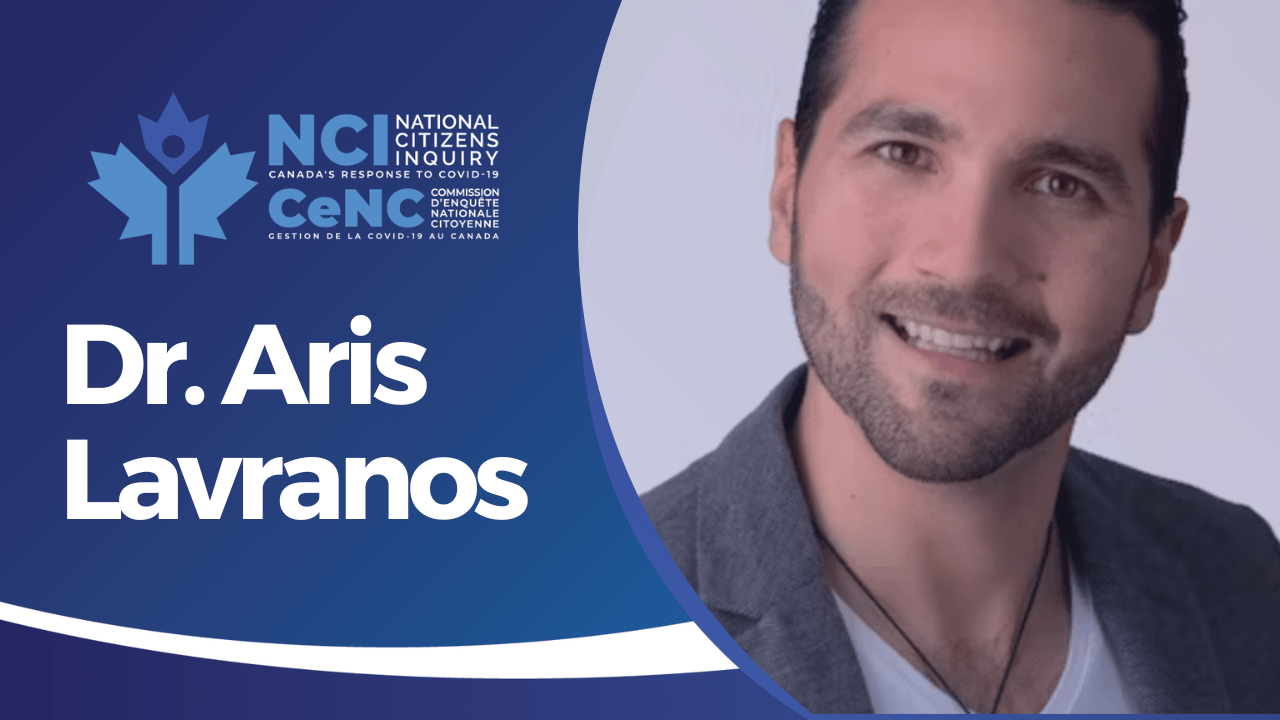Dr. Aris Lavranos is a practising emergency medical doctor who is about to graduate from law school. He reports that he saw very little COVID during the pandemic and the most severely affected patients had several comorbidites. Dr. Lavranos said he is interested in, “pursuing a career in medical malpractice to try and hold hospitals and physicians accountable for the errors that led to the crisis we see”.
View / Listen: Rumble|Apple Podcasts|Spotify|Google Podcasts|Podbean
[00:00:00]
Ches Crosbie
Perhaps I would swear, affirm the witness then? Yes, sir, you affirm that you will tell the truth, the whole truth, and nothing but the truth.
Dr. Aris Lavranos
I do.
Ches Crosbie
Thank you.
Chad Horton
Good morning, sir.
Dr. Aris Lavranos
Morning.
Chad Horton
Could you kindly introduce yourself to the Commission?
Dr. Aris Lavranos
My name is Dr. Aris Lavranos. I have been an emergency physician for about eight years now. I have a very, very small sort of family clinic where I see patients in an outpatient setting, follow-up in the emergency department, which I’ve been doing for a couple of years, really in response to COVID. And I am just about to graduate from law school.
Chad Horton
Now, can you speak a little bit more expansively, Dr. Lavranos, about your history of practice and your areas of practice?
Dr. Aris Lavranos
Sure. So I did my residency and fellowship in Ontario between Kitchener-Waterloo, Hamilton, Collingwood, Southlake, sort of that area. I returned to Nova Scotia about six or seven years ago. I practised all over the province, practised in Digby, practised in Amherst, practised in Kentville, the IWK, Central Zone, Truro, travelled throughout the province. Over the COVID crisis, I practised mostly from Truro, occasionally in Kentville, the IWK, and [inaudible: 00:01:43] emergency departments.
Chad Horton
Okay, so when you say that you practise in emergency departments, would you be classified as an emergency room physician?
Dr. Aris Lavranos
Oh, yeah. And I did my family medicine training with a fellowship in emergency medicine, so a sort of subspecialty in that and that’s what I did almost exclusively.
Chad Horton
And what does emergency medicine contemplate?
Dr. Aris Lavranos
The primary care in general sees everybody as their entrance way into the healthcare system. But generally speaking, the emergency department is the face of the hospital structure to the public. So one of the things that I often like to comment on—and I think some of my other colleagues have mentioned it already—is that public health decisions, the impact of those, is felt in places like the emergency department, perhaps predominantly in the emergency department. A lot of public health consequences aren’t always amenable or agreeable to being seen and followed up in primary care in a family physician’s office. So an acute case of sexually transmitted infection, acute case of a sick child who might not get in to a family medicine appointment, we see a lot of those kinds of consequences.
Chad Horton
Now, you just commented on public health policy a little bit and this is something that came up during the testimony of Dr. Chris Milburn. And this is on the record, on the public record in the news. But Dr. Strang I understand made some comments that, as an emergency room physician, Dr. Milburn should not be commenting on public health policy.
As an emergency physician, are you qualified to comment or have an opinion on public health policy?
Dr. Aris Lavranos
Yeah, absolutely, absolutely. I think stating anything otherwise is a little ludicrous. We see patients who are and are not wearing their helmets in bicycle accidents, right? Who are and are not wearing their seatbelts and this is all within the ambit of public health. You know, if we have epidemics or outbreaks of infections, infectious diseases, measles outbreaks, sexually transmitted infections— I mean, we are exposed to all of those things. And then, of course other consequences of sort of, let’s say, more broad social determinants of health, which also falls in the ambit of public health. So for example, if smoking cessation improves, we do not see as many smoking-related issues. If, you know, children start vaping a lot more, we see a lot more evidence of consequences of vaping in children, and so on. So we are certainly exposed to all of that. And it would be within the ambit of anybody, let alone someone who has a public health background or understanding, expertise, as emergency physicians alone, to be qualified to comment on that.
Chad Horton
And for the record, can you confirm Dr. Lavranos that you’ve provided me with a copy of your CV?
Dr. Aris Lavranos
Yes, I have.
Chad Horton
Okay, and that will be entered as an exhibit for the Commission [TR-16].
Within the scope of your practice—and you’ve told us that you’ve covered a fairly wide geographical area of Nova Scotia—approximately how many patients would you attend with or otherwise treat in the run of a week?
[00:05:00]
Dr. Aris Lavranos
So it’s a good question. Depending on the week, and how heavy I’m working, how many clinic days or how much schooling, or those sorts of things. But when I was working at my fullest, if I did three or four shifts, I worked more than most of my colleagues when I’m working full-time, I acknowledge that. I could see probably five or six thousand patients a year so that would probably be like the upper limits of what I would see if I was working full-time. So that’s 18 to 20, 22 shifts a month, an average of 25 to 30 patients per shift. So it’s a lot, yeah. It’s a big number.
Chad Horton
And at the beginning of the pandemic, let’s go back to early 2020, what were your professional plans?
Dr. Aris Lavranos
Sure. So even before entering— Sort of the idea of going into law, I liked the idea. I’ve always been interested sort of politically, administration-wise. And my idea was to find more training, leadership courses, certifications to try and bring back some of that expertise into the medical field. But certainly, never to stop practising clinical medicine. I love emergency medicine; I really, really love it, and I think I’m quite good at it. So I mean, there’s a tremendous amount of meaning and reward in my life from that.
But then sort of going into law school, I thought I would bring back some of that legal training, do something college-related or administration-related. But as a consequence of the COVID pandemic, my life trajectory has changed dramatically, dramatically. So my pursuits now are— I’ve become very, very disillusioned with the practice of medicine in Canada generally, in Nova Scotia specifically. I think that a lot of the consequences and crises that we are seeing now could have been mitigated, at the very least, if not diverted outright. And so, I am pursuing a career in medical malpractice to try and hold hospitals and physicians accountable for the errors that lead to the crises we see.
Chad Horton
That’s very interesting. And for the benefit of the Commission, can you just briefly talk about when you went to law school and why you did that initially?
Dr. Aris Lavranos
Yeah, so again, that was not the intention. I really, really enjoyed my advanced negligence course, I really enjoyed my tort course in first year. But I liked constitutional law, I liked administrative law, I liked the idea of supporting health care policy. You know, I contributed at least likely to Tim Houston’s plan in Nova Scotia to legal bodies advocating for certain conservative platforms for health care. So that was kind of the direction that I was originally interested in. So the idea of medical malpractice was very, was new. That was later on, definitely.
Chad Horton
And a final question about that, Dr. Lavranos. When did you go to law school? When did you graduate, if you have graduated? And did you continue to practise medicine while you were a student?
Dr. Aris Lavranos
I did. I practised medicine throughout law school. I did sometimes, like, a reduced load. We consider 16-ish, 14 to 16 shifts to be full-time emergency medicine practice per month. I would do 6, 8, maybe even 10 in the month, depending on what the month was, so not quite full-time practice during school. During reading weeks, during the summer, it would jump back up to sort of a much more heavy, heavier workload. I started law school in 2020. But I worked throughout the pandemic; school hadn’t started at the beginning of the pandemic, so I worked pretty intensely over the first nine months of 2020.
Chad Horton
And has that completed or are you still in that process?
Dr. Aris Lavranos
Yeah, so I’m still doing that. My law school has another six weeks or seven weeks of school.
Chad Horton
All right, we’ll shift gears and go back to the pandemic itself and your experience as a physician. Now, based on your education training experience, in any medical literature you had read, what was your understanding on the front end of the pandemic of the danger posed to public health in Nova Scotia by COVID-19?
Dr. Aris Lavranos
Yeah, so I was definitely one of the biggest alarmists when it comes to COVID in the beginning of 2020. January 24th or the 26th, I can’t remember which of those two, but I was on shift in Truro.
[00:10:00]
I was handing over to my chief, or they were sort of on shift with me, and Xi Jinping of the CCP had just announced that they were going to shut down the province of Hubei, Wuhan, whatever. And I had thought to myself, this is going to be peri-apocalyptic. For somebody in such a precarious position of power on the world stage to announce— The political ramifications of that, I thought that this was going to be massive. At that time, I was very much on board: “Two weeks to stop the spread,” I thought it sounded insufficient. I thought that we really needed to have closed borders immediately. This whole idea of Trump having been racist for suggesting that and, “Oh, you should just go and eat at Chinatown,” the Democrats were saying. I thought that this was not appropriate. I was, like, people are underemphasizing how dangerous this could be.
But that perspective only lasted maybe a couple of months. Once we started to see the zero-prevalence data that was coming out at the end of 2020, the beginning of 2021, that’s when it was published. But the data that was out there beforehand—end of 2020, by Bhattacharya and Ioannidis—showed that it was probably nowhere near as fatal as we had thought. The Diamond Princess cruise ship was the first week of February, the second week of February. Nine hundred people of 3,000 contracted the virus I think, something like that. Maybe nine people or seven people died. So not nearly what we had thought or what we had expected.
These videos of people collapsing in China, largely discredited. The reports out of Tehran, largely discredited. Demographic data coming out of New York was very early on in the summer; I think it was like June or July of 2020. Thirty per cent, 35 per cent of all fatalities were happening from long-term care facilities with people who were extremely old and extremely co-morbid. So very quickly, I became sort of disillusioned with the idea of the alarmism and the hysteria that was sort of flowing around COVID.
Chad Horton
Just a brief point of clarification, Dr. Lavranos, for the audience. When you say individuals were largely co-morbid, what does that mean?
Dr. Aris Lavranos
Yeah, so I mean, like, there was this meme that went around when the CDC published the data showing that something like 94 per cent of patients who succumbed to COVID had 2.6 co-morbidities. So those are chronic conditions that stick with you. Now, appropriately a lot of push-back against that was, well, lots of people have co-morbidities. For sure. But the average ages of death were fairly advanced and patients were very co-morbid. And if you looked at the number of patients who were healthy who succumbed to COVID, it was a really much older population. So co-morbid means other medical conditions that could contribute to somebody’s general frailty.
Chad Horton
Thank you, Dr. Lavranos. And you just touched on another point that has come up a couple of times. And I believe one of our commissioners asked about this. But can you briefly explain, as time went on, your understanding of the age stratification of risk associated with COVID-19?
Dr. Aris Lavranos
Yeah, so it was apparent that this was the single greatest contributor to co-morbidity as a risk factor for COVID morbidity or mortality. So prolonged stays in hospital, even if you survived, or passing away from COVID, it was by far the most important. And I would say probably summer/fall of 2020 is when that was, kind of, very well understood—very well understood. There are other co-morbidities that sort of came out, right? Like, early on, the whole idea— Because it was a quote-unquote, “novel virus.” I mean, at least clinically it was a novel thing. I mean, we’ve heard a little bit about the immunology, virology component about it. Coronaviruses are well understood and well-known for a very long period of time. But at least this was a novel virus, even clinically.
And so, the idea was initially a respiratory-predominant kind of concern. And then it became a little bit more of a coagulopathic concern: that what we thought was actually lung harm turned out to be microangiopathic clot disease, renal failure, heart attacks, that kind of a thing. So our nature, our understanding of it evolved and with that, the co-morbidities that could lead to consequences of that also evolved. But age was certainly the biggest risk factor by far. So several orders of magnitude. If you are 80 years old versus 8 years old, it is a massive difference, like, thousands and thousands of times more lethal for the aging population.
Chad Horton
Now, I want to ask you, Dr. Lavranos, about what you personally observed within your capacity as an emergency room physician as the pandemic evolved throughout 2020.
Dr. Aris Lavranos
Yeah, so, in—
Chad Horton
And just a moment, I apologize for interrupting you doctor. I’m specifically asking about COVID illness.
Dr. Aris Lavranos
Yeah, okay. That’s what I was going to follow.
[00:15:00]
Okay, so with respect to COVID specifically, I’ve seen very, very, very little COVID—very little COVID—over the COVID crisis. If we exclude the last six months; if we look at up until Omicron, let’s say, I probably saw 10, maybe 12 people with COVID. Almost all of them had survived. I was seeing them post, right? Like, I saw one person who was sick. They were not sick with me, actually; they became sick later. But I’d see nobody sick with COVID, like having to intubate them, resuscitate them, or anything like that. I never saw anybody like that. I saw maybe a handful of people who had COVID who came in: runny noses, coughs and coughing, sneezing, kind of typical respiratory tract infection sicknesses.
Chad Horton
Well, in the many hospitals that you’ve worked in, as you explained earlier, did you witness any overburdening of hospital resources as a result of COVID admissions?
Dr. Aris Lavranos
Certainly not, certainly not. It was a bit of a joke in the hospital. In Truro, when I was there, we had our COVID unit stocked and ready. We had a COVID physician on all the time, bracing, waiting. Those physicians were starving for work. They would come down and see patients in the emergency department and call. “Do you have any business? Do you have anybody with COVID around? Do you want us to come and see someone? Oh, that sounds like it could be COVID. Do you want me to come and see them?”
So, it was— No, I never saw it. I never saw any overwhelming of hospital resources.
Chad Horton
And, this is a somewhat redundant question, but I think it’s an important question. Do you have any awareness—or can you speak up to today regarding the ultimate mortality numbers appropriately attributable to COVID-19 in Nova Scotia?
Dr. Aris Lavranos
Without having sort of the data here in front of me, the numbers are very low, I would say that. Maybe even extremely low, I would say that. The average age of death in Canada is not much different than it is anywhere else in the world. Tends to be much older, much more co-morbid people. And I mean, like, Nova Scotia, we are older than other places in Canada, there’s no doubt about that. So actually, we’re considerably older compared to Alberta, and so our risk compared to other provinces is probably a little greater to that extent. I mean, at least colloquially I find, in Canada, it tends to be one of little bit of a “heavier set” provinces. So obesity tends to be a risk factor as well. So in that regard, we’re probably a little worse off than the other parts of Canada. But generally speaking, case fatality rates in Nova Scotia are just like they are everywhere else: very, very low.
Chad Horton
Now, would you have been in a position within your capacity as an emergency physician to observe the impact of anything you would attribute to COVID-19 policy or public health policy?
Dr. Aris Lavranos
Yeah, big time. Definitely. And so, this amazing commentary back and forth between Dr. Chris Milburn and Dr. Strang is interesting to me because we do see that a lot. So deaths of despondency and conditions of despondency—which is substance abuse, substance misuse, suicidality, depression, mental health collapse—is just skyrocketing, absolutely skyrocketed. So from a personal point of view, over the last two and a half, three years, it is alarming, distressing, the amount of those kinds of things that we have seen. So I have just dozens and dozens of examples. Dozens of them.
I’ll just relay a few of them that I recall. Two senior citizens, one lady ultimately passed away in hospital. The last thing that she said to me coming from a long-term care facility is, “I’m just so lonely.” And that was the last thing that she said alive. I had an elderly gentleman from a long-term care facility, lovely gentleman. I had seen and known him a couple of times before. He really, really regretted going into a long-term care facility just before the pandemic started. He said that he feels like a prisoner, not allowed to leave, not allowed to go out, not allowed to do things. He’s like, “I would never have done this. This is unimaginable.”
I had an absolutely lovely physiotherapist who came in: two kids, struggling at home, kids aren’t in school, husband was a trucker, gone a long time. She was absolutely hysterical in fear over the risk that the virus posed to her, which was very, very low, exceptionally low to a young, healthy person, no co-morbidities.
[00:20:00]
Hysterical with that, asking for anxiolytic help for her anxiety or depression.
The number of patients we’ve seen who don’t have access to their physicians for chronic care, whether it’s cardiologists, nephrologists, hematologists, rheumatologists, whatever specialist they are. Number of patients who have come in with surgeries delayed, someone needs a gallbladder out, comes in much sicker because their gallbladder surgery has been delayed. Diagnostic imaging: I’ve been waiting for an MRI for nine months; it’s been put off. My pain, my concern, my fear is getting worse. Missed screening appointments for cancers—loads of that.
And then perhaps worst of all, alcoholism. You know, I’m used to seeing a very slow steady state of alcohol-induced liver cirrhosis over the course of a year. I don’t know, probably I see five or less patients. And there were some months over the COVID crisis that I would see five in a month. It was just really, really alarming. A couple of them, one of them I ended up following very closely. Liver transplant. Everything, sort of, fell apart as a consequence of loss of their regular routine, loss of their regular work functioning, loss of their regular recreation, contact with their loved ones. So I mean like people sort of succumb to their vices of choice.
But the worst of it by far was during my shifts at the IWK. I can’t attribute all of this to COVID policy. But I mean, the evidence is overwhelming that, you know, children not being in school, not being exposed to their extracurriculars, not being in touch with the rest of their family units, not being in touch with the rest of their friends, in a household that the parents are struggling more and more financially whereas their co-morbidities are also worsening. So this is not conducive to mental health in a child. And so, when I was at the IWK—especially during end of 2020/2021, somewhere around there—just the amount of mental health use at the IWK was just skyrocketing; emails being sent out, requesting help from the physicians in the emergency department to offload some of the burden from the mental health team as they were seeing such massive volumes of mental health issues.
Meanwhile, there’s no COVID in children that we were seeing. Like children were not coming in, you know, like flooding the department with COVID or were super sick with COVID. Or other things, right? Like not having, you know, regular school-based accidents or other extracurricular accidents, or, you know, all the sort of bread-and-butter things that we would see in a pediatric emergency department. Volumes were much, much, much reduced, whereas mental health was skyrocketing.
And it’s an interesting thing—sorry to keep going here—but it’s an interesting thing because you think to yourself that, well, at least the regular infectious disease patterns were reduced, and that’s pretty good for children, right? And the answer seems to be, well, no, because you’ve got to pay the piper at some point. And the question is, how much interest do you owe? And so, what we’re seeing in the last year with children flooding the emergency department sick, right? Just flooding and calls, like, we’ve never seen anything like this. We can’t keep up, and Advil shortages, Tylenol shortages, all those sorts of things. So I mean, the immune debt that follows from all of this are consequences. So we’re still seeing the consequences of these kinds of COVID policies, for sure.
Chad Horton
Okay. And I do not want to put words in your mouth, but I just want to make sure that I understand your evidence. When you talk about “immune debt” and an escalation in children’s hospitalizations now, am I understanding correctly that what you’re saying is—because they were isolated and they weren’t regularly exposed to germs or pathogens, that they have weakened immune systems?
Dr. Aris Lavranos
Yeah, I mean like that’s kind of the theory of it, right? Well, I guess there are two ways to look at this. One would be this sort of, like, let’s say, economic component of it, right? Like the numbers of it. So if one per cent of children who contract viruses are going to get really sick and need to be admitted—and normally that’s a slow simmer all the time—well, when they all get sick at once because they all return, even if it’s still one percent, the absolute number has risen a lot. So that’s one component of it.
The other component is, there’s probably some cross immunity between viruses. So you know, in 2020 or 2021, you get a little bit of a runny nose or cough or sneezing from some coronavirus or parainfluenza or adenovirus or whatever. And then, a month or two months later or six months later or a year later, you get something that is similar in nature. Well, maybe you have a little bit of some cross immunity and so it kind of helps buffer things.
So I mean these are sort of, like, theoretical things.
[00:25:00]
There’s no RCT to try and figure out how that’s going to work. But certainly, you’ve got to pay the piper at some point. And so, a slow simmer, I guess, would be what’s most preferable.
Chad Horton
Okay. Just a final question in connection with what you just said. And I want to make sure again that I understand you and that the Commission understands you appropriately. What you describe as escalation in pediatric admissions, is it currently related or not related to the COVID-19 virus?
Dr. Aris Lavranos
To my knowledge, it is not. To my knowledge, it is not. I mean like, certainly, there could be. But I mean, the most recent major issue was not associated with the COVID virus, no.
Chad Horton
And one more point of clarification, Dr. Lavranos. When you were speaking, you indicated that there are many issues associated with delayed care. What was the cause of delayed care? You reference diagnostic imaging, you reference surgeries, you reference access to specialists, and some other things. Why was that access inhibited?
Dr. Aris Lavranos
A tremendous amount of resource allocation to preparation and, sort of, shoring of resources in anticipation of COVID harm. For example, I mean, the amount of patients that we see from family physician referrals because of virtual care who were not seen, were not examined. You know, like, we do not have heart rate; we do not have somebody referring somebody who was listening to their chest, you know, felt their pulses, checked their fluid status, those sorts of things. So I mean, we still have a flux of patients who are not being physically seen and who are, at best, being virtually seen, right? So we see all of those kinds of patients.
And then, I mean, there was a big report that came out maybe last year. Sixty-five million dollars over a four-month period were paid to specialists to help support their incomes because they were not seeing patients at the usual rates that they would normally see. So I think that it was several hundred physicians who qualified for that. I think, if I remember correctly, it was over 400. So 400 physicians over four months are getting paid 65 million dollars to support their incomes for not seeing patients. And this is because rooms are being taken for COVID or wings are being taken for COVID or nursing demand is being moved, or whatever the case might be, right?
And so, that has consequences. And the evidence out there for this—apart from, you know, personal experience—is striking. It’s alarming. How much weight gain have people had? How much worse is their hypertension? How much worse is their diabetes? Did somebody have a heart attack that went missed, that ultimately became heart failure because they didn’t want to come in? Did somebody’s diabetic ulcer worsen, progress dramatically, because they were not seen? So these kinds of things are happening all the time as a consequence of— I mean, “neglect” is too harsh a word, but as a consequence of the reprioritization of resources.
Chad Horton
So everything you’ve just described— I think it would be fair to characterize them as negative. The things that you’ve described, would you attribute these negative contingencies to the COVID-19 virus or to public health policy related to COVID-19?
Dr. Aris Lavranos
Right. So looking at what the case fatality rate is, what the demographics of greatest concern, the co-morbidities that are of greatest concern, certainly there could have been— And when we knew this, there could have been a very different approach from a policy point of view to mitigating the harms of the virus. And this has been championed, suggested many, many times by elite physicians, physician groups, states all over the world. So, I mean, the Great Barrington Declaration certainly argued for a focused approach to prevent lockdowns, so the protecting of the most vulnerable.
Did we have a prolific education campaign from public health so that we could educate people on who is at highest risk? I mean, like, certainly by the end of January? No. We did not have public service announcements, town halls advertising and educating the public as to what are the biggest risk factors, the top five risk factors; who is most likely to succumb; and then measures that they can take to protect themselves. We didn’t have anything like that. We had lockdowns of businesses across the board.
So that is a very heavy-handed and, in my estimation, ridiculous approach to what we knew about the virus, even at the end of 2020.
[00:30:00]
Chad Horton
All right. We’re getting close. We have about four minutes left, but there’s something I would like to get into with you if I could. When the vaccines started to roll out, the COVID-19 vaccines, Pfizer, Moderna, et cetera, as an emergency room physician who practised throughout a significant portion of Nova Scotia, did you observe any adverse events associated with these vaccines?
Dr. Aris Lavranos
I did. Yeah, I did. That, in my estimation, were as a consequence of the vaccines. Now, I should say that vaccine policy is one of the COVID policies that I was most, most concerned about and I spent a lot of time in law school sort of researching, studying, and writing about. The rate of adverse events from the vaccines that we saw—that I saw—were much, much greater in scope than I saw as a consequence of the virus itself. Now, that’s my anecdotal experience. I have to admit to that, there’s no doubt about that. But that doesn’t mean that that would be the case across the board, right? Like, from that I could not say that by conclusion the vaccines are unsafe. I couldn’t say that off of my experience.
However, you’ve got to know that these are exceptionally safe—radically, like, near-certainly safe—in order to have mandates. That is the issue to me when it comes to vaccine policy. It’s not the supporting, the encouraging of vaccinations. It’s not the addressing of vaccine hesitancy. It’s not the mitigating of vaccine harms. If you are going to prevent people from circulating in society; if you are going to attach stigma to a personal health decision; if you are going to label these people as denialists, misogynists, racists, whatever you want to call them; if you are going to inflame society— And we have seen the consequences of that repeatedly throughout history, right? Repeatedly. Whether it was the syphilis epidemic; whether it’s HIV epidemics; whether it’s abortion options and choice— The stigmatization, criminalization of health care choices has recurrently in society been a major fault. That is a huge public health consequence of messaging. And so, to inflame those tensions, to drive that divisiveness in society in order to push the vaccines, you’ve got to be really sure that they are, quote–unquote, “safe and effective.” And they need to be both: safe and effective. It’s insufficient to say, “Well, they’re perfectly safe, so who cares? Just give it.” Because if they’re not effective, then what’s the point? You’re still taking a lot of harm without the benefit.
Chad Horton
A couple of follow-up questions on that, and I will try to be brief. So you indicated that you observed adverse events, which you attributed to the vaccine.
Dr. Aris Lavranos
Yeah.
Chad Horton
Was there discussion between you and your colleagues about those observations? And what I’m asking you is, was it your sense and experience that you are not alone in what you were seeing?
Dr. Aris Lavranos
Oh, yes, absolutely. Yeah, the evolution of thought in my department was remarkable. So we have about 20 or 25 physicians. What started off as about one or two physicians kind of talking quietly—hushed tones, emails and messages back and forth; concerns about COVID policy; about what is the actual fatality rate; what are the co-morbidities; what is the messaging like, and so on—kind of really started to grow over the course of the two or three years.
And then as vaccines came out, there was a little bit of, “Well, you know, we’ve got to do everything we can, get everybody immunized,” and so on. And you know, “COVID still poses a major risk.” But then you start seeing a couple of more issues, like, you know, the whole myocarditis, pericarditis. It’s like, “Well, you know, actually, I don’t usually see a lot of myocarditis, but I saw two or three last month,” or “Well, yeah, you know, I don’t see a lot of pericarditis, but I’m seeing quite a bit of it this month.” And you start talking to another one of your colleagues who had [contested that], you’re like, “You know, I saw a lot more than I’m used to seeing too.” And then you start wondering, did I see this in the context of COVID waves in the past? Not really. And so, these kinds of conversations certainly were happening a lot.
Chad Horton
Okay, on that point, two more questions: Did you receive any education or training regarding the monitoring or the reporting of adverse events associated with these vaccines?
Dr. Aris Lavranos
Any training with the monitoring or reporting, no. No, no, not at all. We got a couple of, as I recall, a couple of flyers saying, you know, “You’ve got a report.” There was I think an email or a post-it note that said, “Please document vaccination status on every chart,” so that you can collect data from that point of view.
[00:35:00]
And then because of a really astute and dedicated physician who I work with, we had the link to the reporting address: an electronic link to the reporting address posted around our doctor’s area. The link was about that long, would have taken half a minute to a minute to type, just really cumbersome. Very difficult process.
Chad Horton
And if you did report an adverse event, how long would that have taken to go through the process?
Dr. Aris Lavranos
For an event? I think, probably somewhere between five and fifteen minutes, probably five to fifteen minutes, I would guess.
Chad Horton
What is the significance of that within the context of working in a hospital in Nova Scotia?
Dr. Aris Lavranos
In an emergency department? I think that any of my emergency physician colleagues who are here would attest that that is almost prohibitive. It is far, far too cumbersome, far too cumbersome. Yeah, very, very difficult. Labourious.
Chad Horton
And a final question on that point: What were your observations regarding the attitude and culture in hospital regarding reporting adverse events associated with the COVID-19 vaccines?
Dr. Aris Lavranos
I think the vast majority of people would hope that someone else would report it if it turned out to be such an adverse event. So I think that the majority of my colleagues knew it had to be done, but didn’t think perhaps, like: “Well, maybe the emergency department, maybe right now is not the best time. Maybe I’ll get to it later. Oh, the patient was admitted, hopefully it’ll happen. Oh, they’re going to get followed up from a family physician or a specialist.” Hopefully, somebody else would go about it: I think that was my general sense of the culture of what it was like.
Even the ones who were most diligent, who were, like “I’ve got to do this,” even they found it difficult. Because I mean, 15 minutes, if you were going to do that, let’s just say twice, three times a shift: 15 minutes is definitely enough time to see one patient. So that means that that physician would see maybe two or three fewer patients that shift, just as a consequence of having to go through this reporting. And so, two or three per shift may not seem like that much, but there are many physicians who are working in the department at a single time. So if we have, you know, six, seven, or eight shifts, now that’s suddenly 24 patients we did not get seen over the course of a day as a consequence of having to make this reporting. If that’s the numbers, give or take, that we’re looking at.
Chad Horton
I could talk to you all afternoon, Dr. Lavranos. One more question. It was suggested by a witness yesterday, a nurse with, I believe, 40 years experience: that the under-reporting of adverse events associated with the vaccines was in her estimation a significant issue. Do you agree with that statement based on your experience?
Dr. Aris Lavranos
Yeah, it’s a really good question. Because, on the one hand, under-reporting might be a problem, absolutely. On the other hand, you might have over-reporting by some or by individuals, right? And so, the signal is very, very noisy. There’s no doubt it’s very noisy. The adverse reporting system is not great. I think that there are still other ways of looking at what are the potential consequences that are probably better. So if diagnostic codes for people coming in can be measured, monitored—so like, how many people had a heart attack in January of 2018—we could find that kind of the data, right? And then how many people had a heart attack in January of 2019, and then in 2020, ’21, ’22? So you have sort of bigger systems that can look at this.
The problem is at a much smaller, narrower focus, you can’t really look at it in, perhaps, acute real-time and respond as quickly as you should. So I mean, one of the take-home messages of the pandemic certainly would be to increase the reliability of such a reporting system. Right? If for example: only physicians had access, you needed to have a physician code to register, the system was a lot more streamlined, maybe you could electronically tag a patient’s MRN number or their health card number and just, like, easily auto-populate some kind of a form. So it’s definitely room for improvement, is what I would say.
Chad Horton
Okay, Dr. Lavranos, I will turn you over to the Commission, and I have some questions to provide to them I believe from the audience.
Dr. Aris Lavranos
Thank you.
[00:40:00]
Chad Horton
Alright. Now, does the Commission have any questions for Dr. Lavranos?
Commissioner Massie
Yeah, thank you very much for your testimony. One of the questions that I have, you mentioned that, initially, in the community of doctors you were working with, there was just a few that were sort of aware that maybe some things were not going on as they were presented by the health authority. And with time, with the practice, they evolved.
What would you say now, currently, is the level of awareness of your colleagues in the small group of people you were?
Dr. Aris Lavranos
I would say from, in the group that I talked to and work with closely, I would say nearly 100 per cent. Nearly 100 per cent. So I would say of 20 physicians, 19 of them sort of look back in hindsight and think to themselves this was not— This was not very well managed.
Commissioner Massie
And I guess the corollary question is, how many of them are willing to speak up?
Dr. Aris Lavranos
Me. I think just the one, yeah. I have other colleagues who have helped me write letters. So we wrote a letter to the NSHA [Nova Scotia Health Authority] [Exhibit TR-16b] [Response, Exhibit TR-16c]. I had a meeting with Dr. Strang in 2021. I wrote a letter to Tim Houston and the government [Exhibit TR-16a], and I’ve had many colleagues who have written and signed the letter with me. But this was largely sort of like a personal communication, kind of a sense of anonymity. So how many would be willing to sort of like sit here where I am sitting? It’s just me. The rest of them, too concerned about fallout, too concerned about reputational damage, that sort of thing.
Commissioner Massie
So I guess my question is that— Because of this issue of repercussion to speak up, from your personal path, I guess, why is it that you are coming up and expressing yourself on those issues? Knowing fairly well that it could actually turn out into some consequences which are not very good.
Dr. Aris Lavranos
I’ve got a lovely family. I love my wife very much. She understands, supports me. I am privileged enough to work in an environment where, you know, knock on wood, my job security is still pretty high. I am already having sort of a transition point into a different industry. And the competition that it has and the open-mindedness that it permits is different than healthcare. But all of those things aside, there’s that great Alexander Solzhenitsyn quote that says, “Let the lie come into the world, let it even win, but not through me.” So I take this to heart. I think that it’s really, really important. The spirit of the truth is really important to embrace and to promulgate. So any consequences that come from speaking the truth are consequences that are worth following. So you know, I’m okay.
Commissioner Massie
And maybe one last question. Given that it’s been reported, I think fairly broadly, that the number of therapeutic interventions of different types—as early or sometimes later-on treatment—could actually have a big impact on the outcome.
[00:45:00]
And yet it’s still fairly, I would say, suppressed in practice for a number of reasons.
Do you expect that eventually we will come to terms with that, and the health authority will start seeing that these treatments need to be freely authorized and let the doctors practise medicine?
Dr. Aris Lavranos
Yeah, it’s a great question. It’s actually a big question. My short answer is, I don’t think so, no. I don’t think that that is likely to happen. I think that there are too many— There’s too much of a bureaucracy, too much of an administrative state. Whether it’s the College, whether it’s guidelines that are produced by healthcare bodies like, for example, the Canadian Thoracic Society or the Canadian Cardiovascular Society. And then there’s too much industry and bureaucracy involvement to allow that kind of— And it’s just, generally speaking, not really the approach that we have in Canada. So it would take huge shifts to do it.
On the topic of therapeutics more broadly for COVID, just like I had mentioned about the vaccines, you know. The vaccines: I think it would be disingenuous for anyone—anyone—to say that they met our expectations. They most certainly did not meet our expectations. I think everybody would agree to that. Certainly, transmission changed dramatically—their impact on transmission.
I wrote a huge paper in law school, the impact on transmission was very well understood. I was showing some of my colleagues the data last night. Very early in 2021, like January, February, March, you probably thought to yourself, “Oh my God, this is something that we could really hang our hats on. This is something very impactful.” But by June for sure, when it comes to transmission, there was a huge study that was done—70 countries, 3,000 counties—showing that there was basically no association between COVID rates and the vaccines. That was published by Subramaniam. The data was released, I think, in August, but it was published thereafter. So that was one of them. Obviously, Israel, you know, the Northeast of the US—so the evidence was overwhelming.
Anyway, my point of all that is to say that even if something is not super efficacious, if it’s safe, it’s okay to have a conversation about its utility, right? Like give it a go. And with vaccines or with therapeutics, it’s totally okay.
So my big issue with the therapeutic conversation early on is that maybe azithromycin, maybe hydroxychloroquine are not panaceas. Maybe ivermectin is not a panacea. These things have been around for a very, very, very long time, and we understand their risks and benefits. And if I was going to prescribe azithromycin—which I do all the time, every week; I would say every week I prescribe azithromycin—and I think to myself, what are the pros and the cons? What are the risks? Who should I give it to? Who should I not give it to? And we give it out.
I don’t see much fault in such a system that we’ve embraced for—ever.
Commissioner Massie
Thank you.
Commissioner DiGregorio
Thank you for your testimony today.
Please correct me if I’m wrong, but I think I heard you say that, early in the pandemic time you were very concerned about the potential dangers, and that later on you developed concerns about health issues going undetected because of an allocation of resources having been put towards COVID units that maybe were not being used as busily as expected.
What’s your view on when a reallocation of those resources that were put towards the COVID units should maybe have come back to focus on other health areas?
Dr. Aris Lavranos
I would say probably by the end of 2020, there was sufficient global data to know what was the risk posed. And I think that the strategy could have been much, much better implemented by the end of 2020.
Commissioner DiGregorio
Thank you.
Chad Horton
Thank you very much, Dr. Lavranos.
Dr. Aris Lavranos
Thank you very much, thank you.
[00:49:48]
Final Review and Approval: Jodi Bruhn, August 3, 2023.
The evidence offered in this transcript is a true and faithful record of witness testimony given during the National Citizens Inquiry (NCI) hearings. The transcript was prepared by members of a team of volunteers using an “intelligent verbatim” transcription method.
For further information on the transcription process, method, and team, see the NCI website: https://nationalcitizensinquiry.ca/about-these-transcripts/
Credentials
- ER physician that sees 5000-6000 patients per year.
- (CV on file)
Summary
Dr. Lavranos details his experiences in the emergency department leading up to and during COVID.
He and other frontline physicians (family doctors, emergency physicians, hospitalists, ICU doctors and others) wrote to the Premier and other governing bodies about how concerned they were about the ethics and potential for detrimental societal consequences of mandating COVID-19 vaccination and vaccine passports. Many studies were cited corroborating their position.
He refers to many statistics that support his findings of the unnecessary fear and how co-morbities and age were the biggest factor for a poor outcome to COVID. In the last year there is a “flooding” of children in emergency departments, shortages of medicine, and he believes this is a consequence of the COVID policies.
Since the pandemic, Dr. Lavranos has become interested in “pursuing a career in medical malpractice to try and hold hospitals and physicians accountable for the errors that led to the crisis we see”. He is currently attending law school with the expectation to finish this year.






















